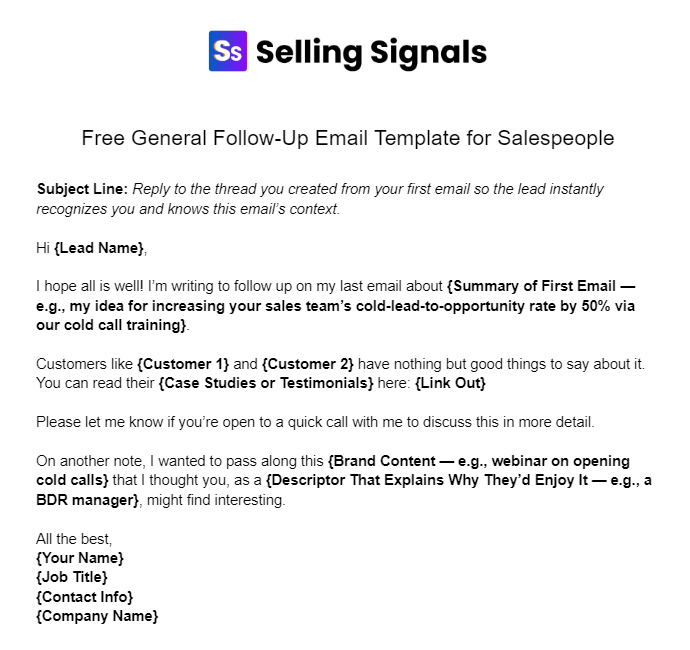-
News & Trends -
Sales -
Marketing Related Topics -
B2B Software Guides Related Topics -
Free Tools & Resources -
- About Us About Us


A follow-up email template is a set of prewritten language and prompts that helps salespeople quickly write personalized follow-up emails for their leads and prospects. They use them to follow up on previous emails, calls, voicemails, or meetings. Having a few solid templates saved in the templates section of Gmail or Outlook, your email marketing software, or your CRM streamlines the follow-up process and can increase your response rates.
These templates are specifically designed for following up with a lead or prospect. For other types of email templates, like one for a sales email, check out our article on best sales email templates. Otherwise, read on for some great follow-up templates.
We created a free email template that works for nearly any follow-up situation involving a salesperson and a prospect or lead, warm or cold. It contains the most important elements of a follow-up email, such as a friendly opening, a brief reminder, and a call-to-action. That said, you can also easily customize the template to fit your business’s specific needs. Go ahead and grab the free template below.

A successful follow-up email template generally consists of a subject line, greeting, opener, reminder, call-to-action (CTA), free value, and sign-off — in that order. While some templates for more specific scenarios might exclude some sections, or add new ones, this is the optimal structure for the average sales follow-up email.
For most follow-up email templates, the best subject line is no subject line. Remind the lead about your last email by simply replying to the thread created by it. That way, once they finish reading your follow-up, they can quickly scroll and read the first email that you’re reminding them about. For emails where there was no initial email — for example, when you’re following up after leaving a voicemail — write a two- to -five-word subject defining your email's purpose.
These are the typical components of a great second, third, or other email to your lead, but you can also use situation-specific templates according to what you're trying to accomplish or how well you know the person you're emailing.
As a salesperson, you’ll find yourself in various scenarios that require the use of follow-up emails. Therefore, it’s important to have some scenario-specific templates saved for your most common situations, from following up after an initial sales call to reaching out again after an unanswered cold email. These templates will enable you to quickly craft and send follow-up emails that engender positive responses and speed up the sales process.
In most cases, a cold lead isn’t going to respond to your first cold email, so it’s important to send them another one. This follow-up email should remind the lead of the context of your first email, and also provide them with free value in the form of a blog post, video, or some other piece of marketing content that’ll earn their trust in your brand’s expertise. Also, restate your CTA somewhere in the email to remind them of the action you’d like them to take.
Below is a template for following up after sending an initial cold email:
Subject Line: Reply to the thread from your first email so the lead can easily see it.
Hi {Name},
Hope your day is going well!
I sent you an email a few days back about how {Company Name} might be able to {Value Proposition — e.g., halve the number of compliance violations you’re getting}.
If that sounds like something that you’re interested in learning more about, please shoot me an email and we can set up some time to talk.
Oh, and before I sign off, I wanted to pass along this {Content — e.g., blog post} about {Topic of Interest — e.g., the changing regulatory landscape of NYC}, which one of my clients said should be required reading for all {Lead Descriptor — e.g., Property Managers in NYC}.
Hope to hear from you.
All the best,
{Your Name}
{Job Title}
{Company Name}
{Phone Number}
{Email Address}
If a cold lead hasn’t responded to your first two cold emails, send another one, this time focusing on building your business’s credibility so as to reduce any doubts that might be holding the lead back from responding. To do this, share links to case studies or testimonials from happy customers that are similar to this lead in terms of size, industry, age (if B2C), or some other relevant attribute.
Here’s a follow-up email template for crafting your second follow-up to a cold email:
Subject Line: Reply to the thread from your first email so the lead can easily see it.
Hey {Name},
Hope all is well!
Since the last email I sent your way, I came across a {Case Study or Testimonial} from a customer who’s also {Similar Attribute — the owner of a small florist business}.
You can read about it here, but long story short, they were able to {Benefit — e.g., increase inbound monthly leads by 32%} after {How You Helped — e.g., we created a Google Ads campaign for them}.
I’d love to talk with you and tell you how I think we can achieve similar results for you, so please let me know if you’d like to set something up.
All the best,
{Your Name}
{Job Title}
{Company Name}
{Phone Number}
{Email Address}
Also known as breakup email, your third follow-up email represents your last attempt to get in touch with a cold lead — through this medium, at least. In this follow-up email, remind them again that your solution will help them solve a major pain point, and then let the lead know that this will be the last email they’ll receive from you. The hope is that the lead has just been too lazy or busy to respond and will now feel a sense of urgency to act.
Subject Line: Reply to the thread from your first email so the lead can easily see it.
I hope you’ve had a good few {Time Since Last Email — e.g., weeks}.
I’ve tried to connect a couple of times to talk about how {Product or Service —e.g., payment gateway} could potentially be a good fit for helping you reduce {Suspected or Common Pain Point — e.g., your involuntary churn rate}, as this plagued many of our clients.
Since I haven't heard back from you, I’m guessing this isn’t the right time, or that you already have this problem covered (if so, I’m happy for you!).
But if you’re still interested, feel free to reach out. And if not, no worries, and I hope you enjoy this {Content — e.g., video you might enjoy on important payment trends}.
All the best,
{Your Name}
{Job Title}
{Company Name}
{Phone Number}
{Email Address}
After receiving a notification informing you that a lead has submitted a webform to opt in for a lead magnet, be it a webinar, newsletter, or something else, it’s critical to send them a follow-up email expressing your excitement and informing them about your product or service. This follow-up email should provide context, tell them what to expect from your lead magnet, offer a helping hand, and plug your solution that you hope to ultimately sell to them.
Below is a follow-up email template that’ll help you nurture leads who opt-in for a lead magnet:
Subject Line: Thanks for {Action — e.g., downloading our checklist, signing up for our newsletter}
Hey {Name},
Hope you’re doing well!
Thanks for {Action They Took — e.g., downloading our free checklist for backpacking}. We hope it helps you {Benefit of Magnet — e.g., have a safe and fun trip out into the wilderness}.
If you have any questions about {Topic of Interest — e.g., backpacking}, please feel free to reach out to me at {Email Address} or {Phone Number}.
Also, if you’re ever in need of a {Product or Service — e.g., lightweight multi-day trip backpacks} that {Value Proposition or Key Differentiator — e.g., don’t cause hip and lower back pain} check out our website to learn more.
Best,
{Your Name}
{Job Title}
{Company Name}
{Phone Number}
{Email Address}
Whenever you meet a lead at a conference, tradeshow, or networking event, it’s a good idea to send them a follow-up email a few days later. This follow-up email should remind them about your conversation, provide them with a reason to talk with you again, and ask them to take next steps with you, whether that’s setting up a sales meeting or connecting you with the decision-maker at their company.
Below we’ve written a follow-up email template for circling back with a lead you recently met:
Subject Line: Great meeting you at {Event — e.g., The Fertilizer Expo}
Hey {Name},
I hope you’ve been doing well since {Event — e.g., The Fertilizer Expo}.
Our conversation about {Conversation Topic — e.g., your initiative to expand your market share into the Northwest} has been on my mind pretty regularly, mostly because I keep thinking of ways that {Your Company Name} would be able to help.
Would you be open to hopping on a call to learn about them? Worst case you walk away with a new perspective on your situation. And best case you find that we’re a great fit.
Please let me know what you think.
Also, though you might like this {Content — e.g., HBS article about scaling sales teams}
All the best,
{Your Name}
{Job Title}
{Company Name}
{Phone Number}
{Email Address}
After conducting a successful sales meeting or phone call, it’s best practice to send a day-of follow-up email thanking them for attending, reiterating the key points and findings of your conversation, and reminding them of next steps. Even if you already scheduled a next step during the meeting, sending this email enhances their level of excitement about your brand and positions you as a professional, both of which improve your chances of closing the sale.
Below is a follow-up email template for reaching out to a prospect after your first sales meeting:
Subject Line: It was great talking with you today!
Hey {Name},
Thanks for taking the time to meet with me today and to discuss how {Product or Service — our CRM} can help you {Value Proposition — e.g., make your lead management process more scalable as your company grows}.
Here are the resources {I Promised To / I Wanted To} share with you:
I’m looking forward to {Next Step — e.g., giving you a tour of the platform in our live demo} next {Date of Next Step — e.g., next Tuesday}.
Based on our conversation, I think you’re going to especially love {Feature or Service — e.g., the lead scoring feature set}. You can preview it here in this short video.
In the meantime, feel free to reach out if you have any questions.
Talk soon!
{Your Name}
{Job Title}
{Company Name}
{Phone Number}
{Email Address}
Sometimes after sending a sales proposal to a prospect you’ll hear nothing back for over a week. In this case, send a follow-up email reminding them about the proposal, offering yourself up as a resource should they have any questions, and restating the value you’re going to contribute once they sign the dotted line. This one excludes the free value element because you want the prospect to focus on reviewing the proposal and nothing else.
Below is a follow-up email template for prospects who’ve yet to sign the proposal you sent them:
Subject Line: Reply to the email thread created by your first email that included the sales proposal as an attachment.
Hi {Name},
Hope you’re doing well!
I sent you a proposal several days back and wanted to quickly touch base to remind you that I’m available to answer any questions you may have during the review process.
We’re excited about the opportunity to collaborate with you and help you {Prospect Goal — e.g., expand your brand’s reach to include Gen Z via social media marketing}.
Again, don’t hesitate to reach out at {Phone Number} or through email.
All the best,
{Your Name}
{Job Title}
{Company Name}
{Phone Number}
{Email Address}
Immediately after leaving a voicemail for a lead or prospect, it’s important that you send a follow-up email as well. This increases the chances that they’ll listen to your voicemail and get back to you. A follow-up email for this scenario should mention that you called them, share the purpose of that call, and ask them to call you back when they get the chance.
Here’s a template for a follow-up email you can send after leaving a voicemail:
Subject Line: Just called about {Topic — e.g., our meeting today}
Hi {Name},
I hope you’re having a great day!
I called you a moment ago {Purpose of Call — e.g., for the live demo we’d scheduled for 4 PM today}. Please give me a call back at {Phone Number} when you get the chance.
In the meantime, check this {Content — e.g., article} out.
Thanks,
{Your Name}
{Job Title}
{Company Name}
{Phone Number}
{Email Address}
Once you’ve established which follow-up email templates tend to work best for you in general or in certain scenarios, consider saving them as canned responses in your email client.
We asked expert salespeople and business owners for some advice for crafting and choosing follow-up email templates. Read on to learn about the importance of A/B testing your templates, avoiding certain words, using an informative and straightforward subject line, and leaving space to talk about each lead’s specific pain point.


Founder
“A/B testing your follow-up email templates is important because it helps determine which template is more effective in driving engagement and conversions. By testing different variations of your templates, you can identify which elements, such as subject line, layout, or tone, are most effective in getting recipients to open and respond to your emails.”
— Brenton Thomas, Twibi


Co-Founder & Chief Revenue Officer
“Never include ‘sorry,’ ‘reminder,’ or ‘‘just’ in your follow-up email templates. ‘Sorry’ can make your message sound apologetic, as if you're at fault for not having received a response. ‘Reminder’ can make the recipient seem like they've already forgotten about the previous correspondence. ‘Just,’ especially before ‘following up,’ can make this email seem trivial. Instead, use language that frames the message as an opportunity or update, and avoid words that can come across as passive or weak.”
— Brandon Mackie, Pickleheads


Co-Founder
“When composing a courteous follow-up email template, the majority of individuals write ‘Follow-Up’ in the subject line. There are a few factors that make it a bad choice. One is that it offers nothing of value. Two, it gives the impression that you’re blaming the reader for their lack of response. Instead, write a subject line that accurately summarizes the purpose of your email or a previous conversation in place of ‘Follow-Up.’ It distinguishes you from the competition.”
— Daniel Thompson, Salt Water Digital


Head of Marketing
“Somewhere in your follow-up email template, leave blank space to write about the specific prospect’s pain, make them feel it, and offer a solution that would make them feel warm and safe. I haven't found a cheat code for how it's best written, so I sometimes make two sets of templates and compare how well they worked after a week or two.”
— Erik Wagner, Plivo
If you follow the above advice, you’ll find that your follow-up emails are more effective at driving positive responses from your leads and prospects. As always, feel free to break the rule.
The optimal number of follow-up emails depends on the situation. For cold leads, it’s best to follow up three times after sending an initial cold email, and sometimes more if you suspect they’re a fantastic fit for your product or service. For warmer prospects, three emails over the course of 1–2 weeks is considered reasonable by most people. After that, expand the interval between follow-ups to 3–4 weeks so as not to pester them.
On a similar note, when following up with a potential customer, vary the content of your emails so that the first, second, and third are all providing a different form of value. Your first follow-up email template to a cold lead might share a piece of educational content, your second might share a case study, and your third and final template might provide a list of unique benefits. This heightens the chances that the lead responds to you.
Following up is an essential part of any lead nurturing strategy. Now that you have some email templates to use as starting points, go create some templates for your most frequent follow-up scenarios. Store them in the templates section of Outlook or Gmail. Or, better yet, upload them into one the best email marketing CRMs, which will allow you to set up automations that streamline the follow-up and email personalization processes.


Sam is a former SaaS sales rep turned freelance writer. He spent his career selling real estate technology to C-suite executives before switching over to blogging, where he now covers sales, marketing, and small business topics. Sam specializes in lead generation, lead nurturing, and deal closing articles for Selling Signals. When he’s not researching the latest sales trends, he’s either penning short stories, hiking, or reading in NYC’s Washington Square Park.

Selling Signals delivers actionable advice for sales and marketing professionals. Learn strategies that help you hit targets, strengthen customer relationships, and win more business. Get expert advice on lead generation, sales processes, CRM software, sales management, and account management directly to your inbox.
Property of TechnologyAdvice. © 2025 TechnologyAdvice. All Rights Reserved
Advertiser Disclosure: Some of the products that appear on this site are from companies from which TechnologyAdvice receives compensation. This compensation may impact how and where products appear on this site including, for example, the order in which they appear. TechnologyAdvice does not include all companies or all types of products available in the marketplace.